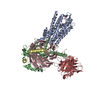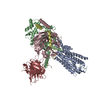[English] 日本語
 Yorodumi
Yorodumi- PDB-7w3z: Cryo-EM Structure of Human Gastrin Releasing Peptide Receptor in ... -
+ Open data
Open data
- Basic information
Basic information
| Entry | Database: PDB / ID: 7w3z | |||||||||||||||||||||
|---|---|---|---|---|---|---|---|---|---|---|---|---|---|---|---|---|---|---|---|---|---|---|
| Title | Cryo-EM Structure of Human Gastrin Releasing Peptide Receptor in complex with the agonist Gastrin Releasing Peptide and Gq heterotrimers | |||||||||||||||||||||
 Components Components |
| |||||||||||||||||||||
 Keywords Keywords | MEMBRANE PROTEIN / GPCR / Gastrin Releasing Peptide Receptor | |||||||||||||||||||||
| Function / homology |  Function and homology information Function and homology informationresponse to external biotic stimulus / positive regulation of respiratory gaseous exchange / positive regulation of behavioral fear response / Fatty Acids bound to GPR40 (FFAR1) regulate insulin secretion / Acetylcholine regulates insulin secretion / phospholipase C-activating G protein-coupled glutamate receptor signaling pathway / neuropeptide receptor activity / PLC beta mediated events / phospholipase C-activating serotonin receptor signaling pathway / entrainment of circadian clock ...response to external biotic stimulus / positive regulation of respiratory gaseous exchange / positive regulation of behavioral fear response / Fatty Acids bound to GPR40 (FFAR1) regulate insulin secretion / Acetylcholine regulates insulin secretion / phospholipase C-activating G protein-coupled glutamate receptor signaling pathway / neuropeptide receptor activity / PLC beta mediated events / phospholipase C-activating serotonin receptor signaling pathway / entrainment of circadian clock / regulation of platelet activation / psychomotor behavior / neuropeptide binding / G protein-coupled peptide receptor activity / regulation of canonical Wnt signaling pathway / glutamate receptor signaling pathway / motor behavior / phototransduction, visible light / social behavior / carbohydrate transmembrane transporter activity / photoreceptor outer segment / neuropeptide signaling pathway / postsynaptic cytosol / response to prostaglandin E / enzyme regulator activity / GTPase activator activity / Peptide ligand-binding receptors / Turbulent (oscillatory, disturbed) flow shear stress activates signaling by PIEZO1 and integrins in endothelial cells / G protein-coupled receptor binding / G-protein beta/gamma-subunit complex binding / Olfactory Signaling Pathway / Activation of the phototransduction cascade / G beta:gamma signalling through PLC beta / Presynaptic function of Kainate receptors / Thromboxane signalling through TP receptor / G protein-coupled acetylcholine receptor signaling pathway / adenylate cyclase-activating G protein-coupled receptor signaling pathway / G-protein activation / Activation of G protein gated Potassium channels / Inhibition of voltage gated Ca2+ channels via Gbeta/gamma subunits / Prostacyclin signalling through prostacyclin receptor / G beta:gamma signalling through CDC42 / Glucagon signaling in metabolic regulation / G beta:gamma signalling through BTK / Synthesis, secretion, and inactivation of Glucagon-like Peptide-1 (GLP-1) / ADP signalling through P2Y purinoceptor 12 / photoreceptor disc membrane / blood coagulation / Sensory perception of sweet, bitter, and umami (glutamate) taste / Glucagon-type ligand receptors / Adrenaline,noradrenaline inhibits insulin secretion / Vasopressin regulates renal water homeostasis via Aquaporins / Glucagon-like Peptide-1 (GLP1) regulates insulin secretion / G alpha (z) signalling events / cellular response to catecholamine stimulus / ADP signalling through P2Y purinoceptor 1 / ADORA2B mediated anti-inflammatory cytokines production / G beta:gamma signalling through PI3Kgamma / Cooperation of PDCL (PhLP1) and TRiC/CCT in G-protein beta folding / adenylate cyclase-activating dopamine receptor signaling pathway / GPER1 signaling / Inactivation, recovery and regulation of the phototransduction cascade / cellular response to prostaglandin E stimulus / G-protein beta-subunit binding / heterotrimeric G-protein complex / G alpha (12/13) signalling events / sensory perception of taste / extracellular vesicle / regulation of cell population proliferation / signaling receptor complex adaptor activity / Thrombin signalling through proteinase activated receptors (PARs) / retina development in camera-type eye / G protein activity / GTPase binding / Ca2+ pathway / fibroblast proliferation / High laminar flow shear stress activates signaling by PIEZO1 and PECAM1:CDH5:KDR in endothelial cells / G alpha (i) signalling events / nuclear membrane / G alpha (s) signalling events / phospholipase C-activating G protein-coupled receptor signaling pathway / G alpha (q) signalling events / Hydrolases; Acting on acid anhydrides; Acting on GTP to facilitate cellular and subcellular movement / Ras protein signal transduction / periplasmic space / learning or memory / Extra-nuclear estrogen signaling / cell population proliferation / protein stabilization / G protein-coupled receptor signaling pathway / lysosomal membrane / GTPase activity / synapse / GTP binding / protein-containing complex binding / Golgi apparatus / signal transduction / extracellular exosome / metal ion binding / membrane Similarity search - Function | |||||||||||||||||||||
| Biological species |   Homo sapiens (human) Homo sapiens (human) | |||||||||||||||||||||
| Method | ELECTRON MICROSCOPY / single particle reconstruction / cryo EM / Resolution: 3 Å | |||||||||||||||||||||
 Authors Authors | Zhan, Y. / Peng, S. / Zhang, H. | |||||||||||||||||||||
| Funding support |  China, 6items China, 6items
| |||||||||||||||||||||
 Citation Citation |  Journal: Proc Natl Acad Sci U S A / Year: 2023 Journal: Proc Natl Acad Sci U S A / Year: 2023Title: Structures of human gastrin-releasing peptide receptors bound to antagonist and agonist for cancer and itch therapy. Authors: Shuman Peng / Yuting Zhan / Dongqi Zhang / Lu Ren / Anqi Chen / Zhou-Feng Chen / Haitao Zhang /   Abstract: Gastrin releasing peptide receptor (GRPR), a member of the bombesin (BBN) G protein-coupled receptors, is aberrantly overexpressed in several malignant tumors, including those of the breast, ...Gastrin releasing peptide receptor (GRPR), a member of the bombesin (BBN) G protein-coupled receptors, is aberrantly overexpressed in several malignant tumors, including those of the breast, prostate, pancreas, lung, and central nervous system. Additionally, it also mediates non-histaminergic itch and pathological itch conditions in mice. Thus, GRPR could be an attractive target for cancer and itch therapy. Here, we report the inactive state crystal structure of human GRPR in complex with the non-peptide antagonist PD176252, as well as two active state cryo-electron microscopy (cryo-EM) structures of GRPR bound to the endogenous peptide agonist gastrin-releasing peptide and the synthetic BBN analog [D-Phe, β-Ala, Phe, Nle] Bn (6-14), in complex with G heterotrimers. These structures revealed the molecular mechanisms for the ligand binding, receptor activation, and G proteins signaling of GRPR, which are expected to accelerate the structure-based design of GRPR antagonists and agonists for the treatments of cancer and pruritus. | |||||||||||||||||||||
| History |
|
- Structure visualization
Structure visualization
| Structure viewer | Molecule:  Molmil Molmil Jmol/JSmol Jmol/JSmol |
|---|
- Downloads & links
Downloads & links
- Download
Download
| PDBx/mmCIF format |  7w3z.cif.gz 7w3z.cif.gz | 258.8 KB | Display |  PDBx/mmCIF format PDBx/mmCIF format |
|---|---|---|---|---|
| PDB format |  pdb7w3z.ent.gz pdb7w3z.ent.gz | 192.8 KB | Display |  PDB format PDB format |
| PDBx/mmJSON format |  7w3z.json.gz 7w3z.json.gz | Tree view |  PDBx/mmJSON format PDBx/mmJSON format | |
| Others |  Other downloads Other downloads |
-Validation report
| Summary document |  7w3z_validation.pdf.gz 7w3z_validation.pdf.gz | 784.1 KB | Display |  wwPDB validaton report wwPDB validaton report |
|---|---|---|---|---|
| Full document |  7w3z_full_validation.pdf.gz 7w3z_full_validation.pdf.gz | 794.1 KB | Display | |
| Data in XML |  7w3z_validation.xml.gz 7w3z_validation.xml.gz | 38 KB | Display | |
| Data in CIF |  7w3z_validation.cif.gz 7w3z_validation.cif.gz | 60.1 KB | Display | |
| Arichive directory |  https://data.pdbj.org/pub/pdb/validation_reports/w3/7w3z https://data.pdbj.org/pub/pdb/validation_reports/w3/7w3z ftp://data.pdbj.org/pub/pdb/validation_reports/w3/7w3z ftp://data.pdbj.org/pub/pdb/validation_reports/w3/7w3z | HTTPS FTP |
-Related structure data
| Related structure data |  32297MC  7w40C  7w41C M: map data used to model this data C: citing same article ( |
|---|---|
| Similar structure data | Similarity search - Function & homology  F&H Search F&H Search |
- Links
Links
- Assembly
Assembly
| Deposited unit | 
|
|---|---|
| 1 |
|
- Components
Components
-Guanine nucleotide-binding protein ... , 3 types, 3 molecules BCD
| #3: Protein | Mass: 41194.844 Da / Num. of mol.: 1 / Mutation: R183Q, Q209L Source method: isolated from a genetically manipulated source Source: (gene. exp.)  Homo sapiens (human) / Gene: GNAQ, GAQ / Production host: Homo sapiens (human) / Gene: GNAQ, GAQ / Production host:  |
|---|---|
| #4: Protein | Mass: 41398.137 Da / Num. of mol.: 1 Source method: isolated from a genetically manipulated source Source: (gene. exp.)  Homo sapiens (human) / Gene: GNB1 / Production host: Homo sapiens (human) / Gene: GNB1 / Production host:  |
| #5: Protein | Mass: 9242.612 Da / Num. of mol.: 1 Source method: isolated from a genetically manipulated source Source: (gene. exp.)  Homo sapiens (human) / Gene: GNG2 / Production host: Homo sapiens (human) / Gene: GNG2 / Production host:  |
-Protein / Protein/peptide / Antibody , 3 types, 3 molecules ALH
| #1: Protein | Mass: 99534.102 Da / Num. of mol.: 1 / Mutation: E198A, N199A, K265A, I157A Source method: isolated from a genetically manipulated source Details: Fusion protein of Maltodextrin-binding protein, HiBit expression tag and Gastrin-releasing peptide receptor Source: (gene. exp.)   Homo sapiens (human) Homo sapiens (human)Gene: malE, GRW33_05015, GRPR / Production host:  |
|---|---|
| #2: Protein/peptide | Mass: 1375.604 Da / Num. of mol.: 1 / Source method: obtained synthetically / Source: (synth.)  Homo sapiens (human) Homo sapiens (human) |
| #6: Antibody | Mass: 32785.582 Da / Num. of mol.: 1 Source method: isolated from a genetically manipulated source Source: (gene. exp.)  Homo sapiens (human) / Production host: Homo sapiens (human) / Production host:  |
-Details
| Has ligand of interest | N |
|---|---|
| Has protein modification | Y |
-Experimental details
-Experiment
| Experiment | Method: ELECTRON MICROSCOPY |
|---|---|
| EM experiment | Aggregation state: PARTICLE / 3D reconstruction method: single particle reconstruction |
- Sample preparation
Sample preparation
| Component | Name: Human Gastrin Releasing Peptide Receptor in complex with the agonist Gastrin Releasing Peptide and Gq heterotrimers and ScFv16 Type: COMPLEX / Entity ID: all / Source: RECOMBINANT |
|---|---|
| Source (natural) | Organism:  Homo sapiens (human) Homo sapiens (human) |
| Source (recombinant) | Organism:  |
| Buffer solution | pH: 7.5 |
| Specimen | Embedding applied: NO / Shadowing applied: NO / Staining applied: NO / Vitrification applied: YES |
| Vitrification | Cryogen name: ETHANE |
- Electron microscopy imaging
Electron microscopy imaging
| Experimental equipment |  Model: Titan Krios / Image courtesy: FEI Company |
|---|---|
| Microscopy | Model: FEI TITAN KRIOS |
| Electron gun | Electron source:  FIELD EMISSION GUN / Accelerating voltage: 300 kV / Illumination mode: OTHER FIELD EMISSION GUN / Accelerating voltage: 300 kV / Illumination mode: OTHER |
| Electron lens | Mode: BRIGHT FIELD |
| Image recording | Electron dose: 64 e/Å2 / Film or detector model: GATAN K2 BASE (4k x 4k) |
- Processing
Processing
| Software | Name: PHENIX / Version: 1.18.2_3874: / Classification: refinement |
|---|---|
| EM software | Name: PHENIX / Category: model refinement |
| CTF correction | Type: PHASE FLIPPING AND AMPLITUDE CORRECTION |
| 3D reconstruction | Resolution: 3 Å / Resolution method: FSC 0.143 CUT-OFF / Num. of particles: 2380323 / Symmetry type: POINT |
 Movie
Movie Controller
Controller



 PDBj
PDBj




























